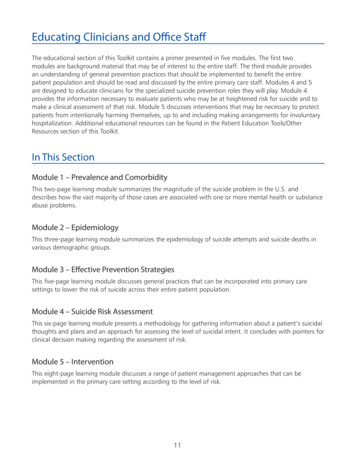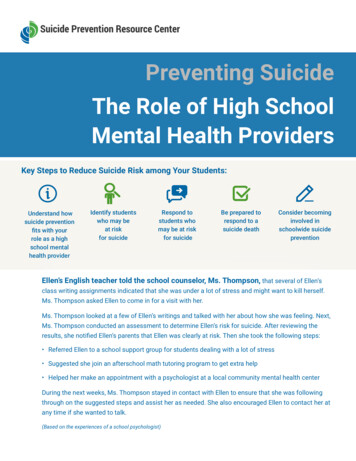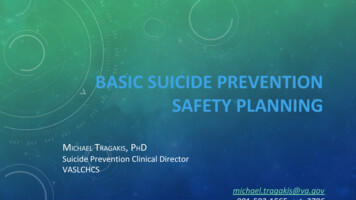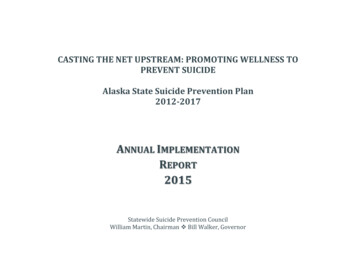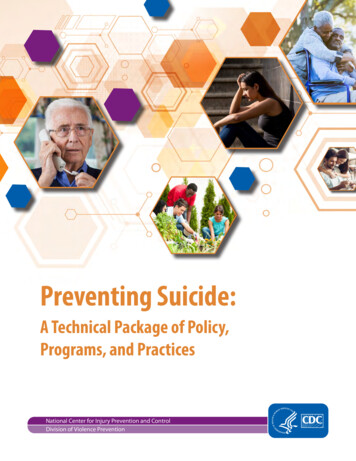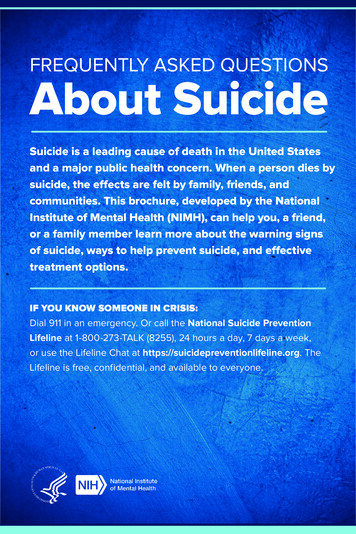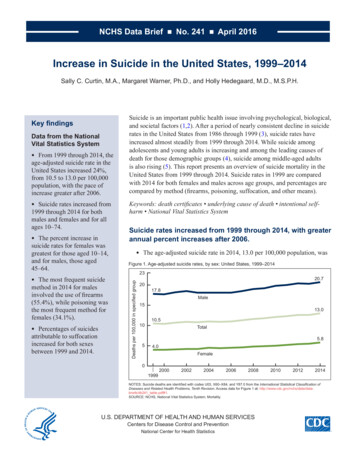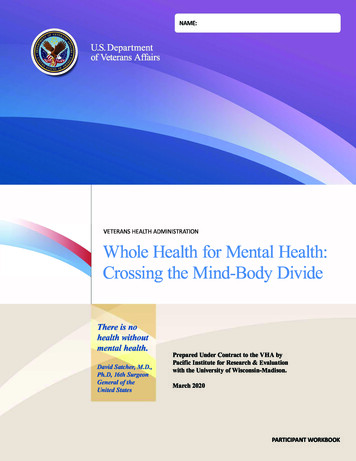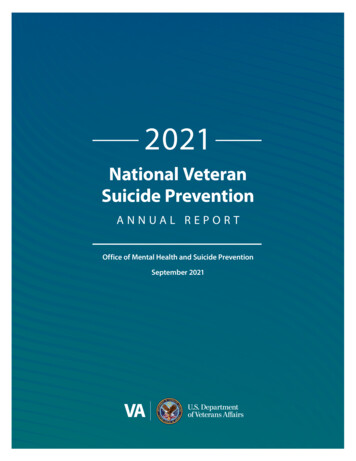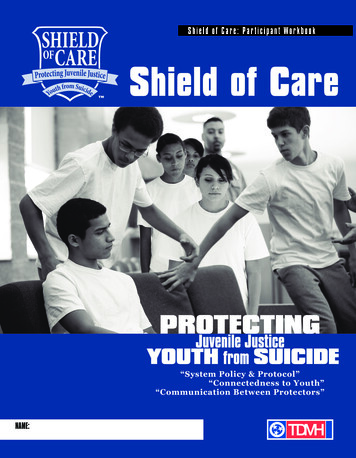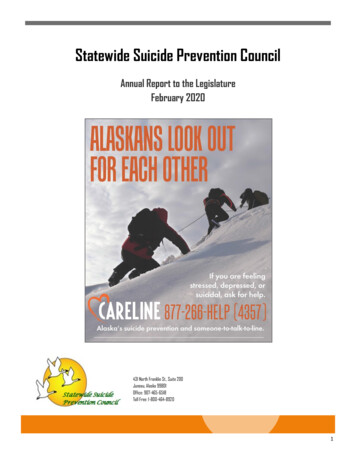
Transcription
Statewide Suicide Prevention CouncilAnnual Report to the LegislatureFebruary 2020431 North Franklin St., Suite 200Juneau, Alaska 99801Office: 907-465-6518Toll Free: 1-800-464-89201
Statewide Suicide Prevention CouncilAnnual Legislative Report 2020IntroductionThe State of Alaska’s Statewide Suicide Prevention Council (SSPC) was established by the Alaska State Legislature in 2001 (AS44.29.350) and serves as an advisory council to the Legislature and Governor regarding suicide awareness and prevention.The duties of the Council are to: improve health and wellness throughout the State by reducing suicide and its effect on individuals, families, and communities; broaden the public’s awareness of suicide and the risk factors related to suicide; enhance suicide prevention services and programs throughout the state; develop healthy communities through comprehensive, collaborative, community-based, and faith-based approaches; develop and implement a statewide suicide prevention plan; and, strengthen existing and build new partnerships between public and private entities that will advance suicide prevention effortsin the State.The Council is located within the Department of Health and Social Services and includes 17 council members; 13 voting members, 2non-voting members representing the Alaska State House of Representatives and 2 representing the Alaska State Senate. The Governor appoints the 13 voting members from designated stakeholder groups.Current Council members include:Barbara Franks, Chairperson, Survivor — KenaiWilliam Martin, Vice-Chair, Alaska Federation of Natives — JuneauSharon Fishel, Secretary/Treasurer, Education and Early Development — JuneauMonique Andrews, Officer-at-Large, Military — Eagle RiverRoberta Moto, Rural member off the road system — DeeringJulie Vincek, Secondary schools — AnchorageAl Wall, DHSS — AnchorageSarah Chen, Youth Member — AnchorageBrenda Moore-Beyers, Alaska Mental Health Board — AnchorageCynthia Erickson, Public — TananaMarcus Sanders, Clergy — AnchorageSenator Peter Micciche — SoldotnaSenator Tom Begich — AnchorageRepresentative Sharon Jackson — Eagle RiverRepresentative Sara Hannan — JuneauVACANT, Statewide youth organizationVACANT, Alaska Advisory Board on Alcoholism and Drug AbuseSSPC Chair Barbara Franks distributing outreachmaterials at the Alaska Federation of Natives Conference2019.The Council is collocated with the Advisory Board on Alcohol and Drug Abuse and the Alaska Mental Health Board, which collectively share an Executive Director, Beverly Schoonover, who was hired in 2019. The Council also has one fulltime staff.Gov. Mike Dunleavy signed Senate Bill 10 in June 2020 to extend the Council to June 30, 2027. The Council was scheduled to sunseton June 30, 2019, but was extended after unanimous bipartisan support of the bill, sponsored by Sen. Scott Kawasaki, D-Fairbanks.The Division of Legislative Audit completed a favorable audit in 2019 recommending that the legislature extend the Council’s termination date to 2027.2
Council Activities 2019-2020Most of the Council’s activities involve collaboration between stakeholders, supporting various outreach and educational programs, and providing technical assistance as needed. While there are other governmental and private sector agencies with a common goal in the prevention of suicide, no other organization performs the statewide coordinator function.Quarterly Council MeetingsThe Council meets on a quarterly basis, generally conducting two in-person meetings in various urban and rural communitiesacross the state, and two video/teleconference meetings. The Council also holds some subcommittee and ad-hoc meetings whennecessary.In March 2019 the Council met in Juneau for its spring quarterly meeting. Along with its regular business meeting and site visits,the Council partnered with the American Foundation for Suicide Prevention – Alaska Chapter to host a Lunch & Learn at the AlaskaState Capitol on suicide prevention, as well as hosted a community candle light vigil in partnership with the Juneau Suicide Prevention Coalition on the Capitol steps that was attended by hundreds of Alaskans.In October 2019 the Council held its fall quarterly meeting in Wasilla, where it partnered with a number of local organizations and groups, including the Alaska ArmyNational Guard’s Resilience, Risk Reduction, and Suicide Prevention leadership, theMat-Su Opioid Task Force, and the Valley Awareness for Prevention of Suicide(V.A.P.S.) coalition.Council members and its legislative members also were trained by high school andmiddle school students in the Mat-Su School District’s “Navigating Transitions:Promoting Wellness to Prevent Suicide,” an online peer-to-peer education programdeveloped with funds from the Suicide Awareness Prevention & Postvention (SAPP)program that is administered by the Council and the Department of Education and SSPC Meeting– Wasilla, Alaska 2019Early Development The Council also hosted a community reception in partnershipwith the Alaska Mental Health Trust Authority at My House, the community youth homeless center that also administers suicideprevention efforts for youth in the Mat-Su Valley.In February 2020 the Council held a winter in-person meeting in Juneau, where it met with numerous community partners including the Juneau Suicide Prevention Coalition, Bartlett Regional Hospital behavioral health staff, and toured the ‘Forget-me-Not’Housing First project. Other quarterly meetings in 2019 were held via video/teleconference.Suicide Awareness Prevention & Postvention School Based ProgramThe Council has had a longtime partnership with the Department of Education & Early Development (DEED) to administer theSuicide Awareness Prevention & Postvention (SAPP) program. Along with other school based suicide prevention activities includingeducator trainings and crisis response, the SAPP program distributes grants to school districts to promote suicide prevention andawareness in their communities. Many of the grantees include peer-to-peer awareness and intervention models that have shownto be highly effective in youth suicide prevention efforts.Current grantees include: Anchorage School District; Mat-Su School District; Juneau School District; Petersburg School District;North Slope School District; Bering Strait School District; Fairbanks School District; Lower Yukon School District; and the KenaiSchool District. SAPP grant funds are distributed equally (50/50) to both rural and urban school districts.Along with some funding going toward technical assistance, the SAPP program also funds the development of DEED’s eLearningcourses related to suicide awareness, prevention, and postvention. These courses comply with the State of Alaska’s statutoryrequirements to provide free suicide prevention trainings to all certified educators in Alaska. The SAPP program also pays for 500seats open to the public to take these courses each year.Current eLearning courses that are available to Alaskan educatorsand the public include: Overcoming ACEs in Alaska’s SchoolsTrauma-Sensitive SchoolsTrauma Engaged & Practicing Schools Trauma Engaged Educator Tools & Techniqueswith hands-on activities for:Classroom practiceSelf-regulationMind body connectionEmotional intelligence3
Suicide Awareness Prevention & Postvention School Based Program (Cont.)As of July 1, 2019, the four eLearning courses related to suicide have been completed more than 3,000 times. Suicide Awareness Part A: 2546 enrolled or completed; (1985) completed Suicide Prevention Part B: 1223 enrolled or completed; (764) completed Suicide Intervention Part C: 948 enrolled or completed; (539) completed Suicide Postvention Part D: 900 enrolled or completed; (345) completedBetween the eLearning trainings, student engagement, and community outreach, the SAPP program has reached 22,675 Alaskanssince Fiscal Year 2017. In addition to the more traditional suicide programming DEED administers through district grants and training, DEED is often able to respond to unforeseeable district crisis with this funding. DEED can authorize grant funds to be allocatedfor crisis counseling and even provide funding for external counseling support to a school in crisis, such as the Katovik school fire.Lethal Means Reduction ProjectThe Council decided to focus its efforts in 2019 on Strategy 3.1 of the Statewide Suicide Prevention Plan, which is: “Communitieswill partner with diverse organizations to raise awareness about limiting access to lethal means of suicide.” The Council received aone-time funding allotment of 75,000 from the Alaska Mental Health Trust Authority (the Trust) to conduct community outreachregarding lethal means reduction throughout Alaska. Alaska has a high number of firearm fatalities, with a mortality rate nearly double the nationalrate (19.7 vs. 10.3 per 100,000 persons, respectively). (Alaska Violent Death Reporting System(AVDRS) Of the 1,000 firearm fatalities in Alaska between 2009-2015, 750 (75%) were deaths by suicide,152 (15%) were homicide, and the remaining 98 (10%) were due to unintentional injury, legalinterventions or were undetermined. Nearly 2/3 of all suicides in Alaska involve firearms. Alaskans are four times more likely to die by suicide from a firearm than in a homicide. Nearly 1/3 of all suicide deaths by firearm in Alaska are by someone who has experienced atleast one mental health problem such as depression, anxiety disorder, or bipolar disorder.According to Alaska Health Analytics and Vital Records. 85-95 percent of suicide attempts with a firearm are fatal. According to the CDC fatal injurydata.The Council partnered with the Trust and the Division of Behavioral Health to create a poster,brochure, and business cards to distribute to the public. The materials were debuted at the AlaskaSchool Safety & Well-Being Summit in September 2019. The materials have been distributed toeducators, nonprofit organizations, hunter safety instructors, gun owners, law enforcement, andmore.Reducing Lethal Means CampaignBrochure 2020In October 2019, the Council partnered with the U.S. Department of Veterans Affairs (VA) and theAlaska Federation of Natives (AFN) to distribute the materials as well as 200 gunlocks at the AFN Convention in Fairbanks. The gunlocks were donated by the VA and the resource table was donated by AFN.The Council will continue working on its Lethal Means Reduction Project throughout Fiscal Year 2020 and plan to collaborate withthe Alaska Commission on Aging on materials to be placed in senior citizen retirement and nursing homes, and collaborate with the4Juneau Suicide Prevention Coalition on a radio public service announcement campaign.
Alaska CarelineThe Council continues to partner with and support the efforts of the statewide toll free Careline Crisis Intervention line. Careline isa crisis line based in Fairbanks that is staffed 24 hours a day, seven days a week, by trained Alaskans. It is not strictly for peopleexperiencing suicidal ideation, but is also a line for people going through any crisis that need someone to talk to. If all the Carelineworkers are busy on the phone at 1-877-266-4357, then they are automatically transferred to the National Suicide PreventionLifeline.The call volume to Careline continues to grow, nearly tripling in calls over the past 8 years. In 2012, when call volume was firstrecorded, 6,956 people called the Careline. In 2019, Careline received 20,617 calls.The Council continues to advise Careline as well as help create promotional materialsto distribute to the public. For the 2020 Legislative Session the Council partnered withLegislative Affairs Agency, Careline, and the Department of Health & Social Services tocreate a new campaign titled, “Alaskans Look Out for Each Other.” Posters andmagnets were distributed to every legislative office and put up in the Capitol to helppromote mental health during session.Legislative Outreach Campaign Materials-2020Suicide in AlaskaSuicide is a serious public health issue in Alaska that affects all Alaskans, regardless of age, culture, race, region, or socio-economicbackground. While suicide rates continue to rise across the United States, Alaska has one of the highest of any state, at nearlydouble the national average. The number of suicide deaths and rates decreased in 2018 (the latest figures available) to the lowestnumbers since 2014, but is still well above the national rate. In 2018 there were 181 Alaskans that died by suicide, a rate of 24.5per 100,000 people, down from 197 deaths by suicide in 2017, or a rate of 26.9. The national rate of suicide in 2017 was 14 per100,000, and 14.2 in 2018. 1,728 Alaskans died by suicide between 2009 and 2018, accounting for 4.2% of all Alaskan deaths, and making suicide the 6thleading cause of death in that time period. According to Alaska Health Analytics and Vital Records. In 2018, suicide was the leading cause of death for youth and young adults age 15 to 24 in Alaska (44.2 per 100,000). Alaska Natives and American Indians (AN/AI) continue to be one of the most at-risk populations for suicide in Alaska, with arate of more than three times the national average, an alarmingly high rate of 41.9 per 100,000 in 2018. The rate amongAlaska Native youth age 15-24 years was 119.6 per 100,000, more than double the rate of all Alaskans in that age group. Of 562 suicide deaths between 2015 and 2017 that underwent toxicology testing, 394 (70%) tested positive for alcohol orother drugs (opiates, amphetamines, marijuana). Between 2012 and 2017, 37% of the people who died by suicide had a current mental health disorder; 36% had been treatedfor a mental health disorder during their lifetime; and 22% were being treated for a mental illness at the time of their death. Suicide continues to be a risk in Alaska’s aging population as well; between 2009 and 2018, Alaskans aged 60 to 79 had thethird highest number of suicides of any age demographic. Older males are at an even greater risk, with a rate of 70.3 per100,000 Alaska men between 70 and 74 years old.ConclusionThe Statewide Suicide Prevention Council will continue to work with local suicide prevention groups, suicide survivors, partners andother stakeholders to implement the goals and strategies in the 5-year suicide prevention plan. Both upstream and primaryprevention efforts are needed to reduce suicide in Alaska. Strong state leadership, dedicated program efforts, collaboration andlong-term sustainable resources are needed to address suicide in Alaska and the ‘web of causality’ that impacts the health and well5-being of Alaskans.
Region 1: North Slope BoroughRegion 2: Northwest Arctic BoroughRegion 3: NomeRegion 4: Wade Hampton, BethelRegion 5: Dillingham, Bristol Bay BoroughRegion 9: Valdez-CordovaRegion 6: Kodiak Island BoroughRegion 10: Yukon-Koyukuk, Fairbanks, DenaliRegion 7: AleutiansRegion 11: SoutheastRegion 8: Mat-Su, Anchorage, Kenai PeninsulaSource: Alaska Health Analytics and Vital Records Section. Updated 8/20196
prevention efforts are needed to reduce suicide in Alaska. Strong state leadership, dedicated program efforts, collaboration and long-term sustainable resources are needed to address suicide in Alaska and the 'web of causality' that impacts the health and well-being of Alaskans. Legislative Outreach ampaign Materials-2020
